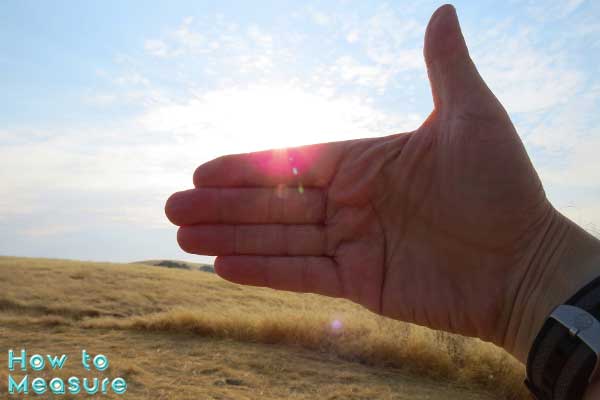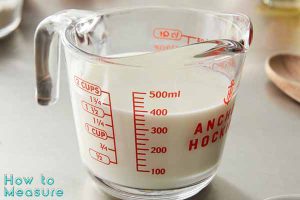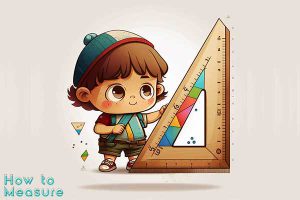Have you ever been outside and wanted to know how much sunlight you have left? Measuring the remaining sunlight with your hand is a simple and effective way to get an approximate estimate. In this article on How to Measure, you will learn how to measure remaining sunlight with your hand and the benefits, tips, and warnings associated with this method.
Overview of Method for measuring remaining sunlight with your hand
Measuring the remaining sunlight using your hand can be quick and convenient, especially when you don’t have any tools or equipment. This technique, known as the hand or the hand shadow method, allows you to estimate the approximate time remaining until sunset based on the sun’s position on your hand.
Here’s a simple overview of how to use the hand method to measure the remaining sunlight:
- Find an open area where you have a clear view of the sky and the sun. Ensure no obstructions or tall objects block the sun’s path.
- Extend your arm before you, keeping it parallel to the ground. Position your hand with the palm facing you and the fingers close together.
- Place your hand vertically so that it aligns with the horizon. The bottom edge of your hand should be touching the horizon, while the top edge represents the sun’s position.
- Observe the space between the top edge of your hand and the sun’s actual position. Each finger width corresponds to approximately 15 minutes of daylight remaining until sunset.
- Count the finger widths between the top edge of your hand and the sun. Multiply this number by 15 to estimate the remaining time in minutes.
Keep in mind that this method provides an approximate measurement and is influenced by factors such as the angle of the sun, your location on Earth, and the time of year. Additionally, it’s important to note that this method may not be as accurate as using more precise instruments like sundials, solar calculators, or smartphone applications designed specifically for tracking sunset times.
Nevertheless, the hand method can be useful when you need a quick estimation of the remaining sunlight. It’s handy for outdoor activities, gardening, or simply staying aware of daylight hours. Use it as a rough guideline and consider other reliable sources for precise sunset times.
Step-by-Step Instructions
Here are step-by-step instructions for using the hand method to measure the remaining sunlight:
- Find an open area with an unobstructed sky and sun view. Move away from tall buildings, trees, or any other objects that may cast shadows.
- Stand in a comfortable position and extend your arm fully in front of you, keeping it parallel to the ground.
- Close your fingers and bring them together, with your palm facing you. Make sure your hand is flat and not tilted.
- Align the bottom edge of your hand with the horizon, ensuring that it touches the line where the sky meets the land or buildings.
- Look at the top edge of your hand. It represents the position of the sun in the sky.
- Observe the space between the top edge of your hand and the sun’s actual position. Please take note of how many finger widths or sections are between them.
- Each finger width or section typically corresponds to approximately 15 minutes of daylight until sunset.
- Count the number of finger widths or sections between the top edge of your hand and the sun.
- Multiply the number of finger widths by 15 to estimate the remaining time in minutes until sunset.
- Use this estimation as a rough guideline for planning your activities or to know how much daylight is left.
Remember that this method provides an approximation and can be influenced by various factors, including the sun’s angle, your location, and the time of year. Cross-reference your estimation with more accurate sources such as weather apps, websites, or dedicated sunset time calculators for precise information is always a good idea.
Practice and experience will help you refine your estimates over time, and you’ll become more familiar with the correlation between finger widths and the actual time remaining until sunset.
Benefits of Measuring Sunlight with Your Hand
Measuring sunlight using the hand method offers several benefits that make it a convenient and practical approach. Here are some of the benefits:
- Quick and Easy: The hand method provides a quick and easy way to estimate the remaining sunlight without the need for any special equipment or tools. You can use your hand and rely on visual cues to make an estimation.
- Portable and Always Accessible: Since you always have your hand with you, this method is portable and accessible wherever you go. Whether outdoors, hiking, camping or simply walking, you can easily measure the remaining sunlight using your hand.
- No Technical Knowledge Required: Unlike other methods involving sophisticated instruments or calculations, the hand method requires no technical knowledge. It is a simple visual estimation that anyone can learn and apply without specialized training.
- Engages Your Senses: Measuring sunlight with your hand engages your senses and connects you with the natural environment. It encourages you to be present, observe the position of the sun, and appreciate the changing light throughout the day.
- Useful in Emergency Situations: In situations where you may be without access to technology or reliable sources of information, the hand method can be particularly useful. It gives you a rough idea of the remaining daylight, which can be crucial for planning your activities or finding your way in unfamiliar surroundings.
- Increases Awareness of Daylight Changes: By regularly using the hand method, you become more attuned to the changing patterns of sunlight throughout the day and across different seasons. This increased awareness can deepen your understanding of natural rhythms and enhance your connection with the natural world.
- Educational and Fun: Measuring sunlight with your hand can be educational and fun, especially for children. It provides an opportunity to learn about the sun, shadows, and the concept of time in a hands-on and interactive way.
While the hand method may provide a different level of accuracy than precise instruments or technology, it serves as a practical estimation tool for everyday use. It helps you stay more connected with the natural environment, make informed decisions, and appreciate the beauty of daylight.
Potential Challenges
While measuring sunlight with your hand using the hand method is a convenient and accessible approach, it’s important to be aware of some potential challenges that you may encounter:
- Subjectivity: The hand method relies on visual estimation, which can vary from person to person. The size and shape of hands, as well as individual perception, may affect the accuracy of the measurement. This subjectivity can introduce some level of uncertainty into the results.
- Environmental Factors: Various environmental factors can affect the accuracy of the hand method. Cloud cover, haze, and other atmospheric conditions can impact the visibility of the sun and make it more challenging to estimate the remaining sunlight accurately.
- Inconsistent Hand Positioning: To get an accurate measurement, you must position your hand consistently each time you use the hand method. However, there may be some consistency in the estimation due to different hand positions or variations in how you hold your hand. It’s important to practice and develop a consistent hand positioning technique.
- Lack of Precision: The hand method roughly estimates the remaining sunlight and is less precise than specialized instruments or technology. If you require precise and accurate measurements, it’s advisable to use reliable sources of information or equipment specifically designed for measuring sunlight.
- Time of Day and Location: The accuracy of the hand method can vary depending on the time of day and your geographical location. The angle and intensity of sunlight change throughout the day and can differ based on your position on the globe. Therefore, the hand method may be more effective during certain times of the day or in specific geographic regions.
- Limited Use at Night: The hand method is primarily designed to measure daylight and may not be applicable for measuring the remaining hours of darkness. It’s important to recognize its limitations and seek alternative methods for measuring nighttime hours or when the sun is not visible.
Despite these potential challenges, the hand method remains a practical and useful technique for estimating the remaining sunlight in many everyday situations. By understanding its limitations and using it in conjunction with other sources of information, you can make more informed decisions and better appreciate the dynamic nature of daylight.
Conclusion
In conclusion, measuring the remaining sunlight with your hand is a simple and accessible method that can roughly estimate daylight hours. Using your hand as a visual reference and observing the sun’s position around your hand, you can gauge the approximate amount of daylight remaining.
This method offers several benefits, including its convenience and ease of use. You don’t need specialized tools or equipment, making it readily available. It can be especially useful in outdoor activities, such as hiking, camping, or gardening, where knowing the remaining daylight can help you plan your activities accordingly.
Additionally, measuring sunlight with your hand promotes a deeper connection with nature and enhances your awareness of the changing daylight hours. It encourages you to pay attention to the position and intensity of the sun, fostering a greater appreciation for the natural rhythms of the day.
However, it’s important to remember that the hand method has limitations. It relies on visual estimation, which can introduce subjectivity and variability in the results. Environmental factors, inconsistent hand positioning, and the lack of precision compared to specialized instruments are factors to consider.
To overcome these limitations, it is advisable to use the hand method in conjunction with other sources of information, such as weather forecasts or dedicated sunlight tracking apps. These resources can provide more accurate and precise data about sunrise, sunset, and the length of daylight hours.
Ultimately, measuring remaining sunlight with your hand is a practical technique that can serve as a quick and accessible method to estimate daylight hours. By understanding its limitations and combining it with other tools and information, you can make more informed decisions and effectively plan your activities based on the available sunlight.












